 |
 |
 |
| |
FUZEON: EFFICACY OF ENFUVIRTIDE (Fuzeon) IN SUBGROUPS OF PATIENTS THROUGH 48 WEEKS OF THERAPY IN THE TORO TRIALS
|
| |
| |
Poster 9th European AIDS Conference Warsaw, Poland, October 2003
Walmsley S1, Clotet B2, Cooper D3, Lalezari J4, Nelson M5, O'Hearn M6, Piliero P7, Reynes J8, DeMasi R9, Delehanty J9, Chung J10, Salgo M10 for the TORO Study Team. 1University of Toronto, Toronto, Ontario, Canada;2 Hospital Germans Trias i Pujol, Barcelona, Spain; 3NCHECR, Sydney, Australia; 4Quest Clinical Research, San Francisco, CA, USA; 5 Chelsea and Westminster Hospital, London, UK; 6OHSU, Portland, OR, USA; 7Albany Medical College, Albany, NY, USA; 8CHU Gui de Chauliac, Montpellier, France; 9 Trimeris, Durham, NC, USA; 10 Roche, Nutley, NJ, USA
Reported by Jules Levin
Enfuvirtide (ENF) is the first HIV fusion inhibitor approved for the treatment of HIV-1 infection in treatment-experienced patients. ENF targets HIV-1 gp41, thereby inhibiting HIV fusion to host cells.
In two Phase III studies, TORO 1 and TORO 2, treatment with ENF plus an optimized background (OB) antiretroviral regimen resulted in significant improvement in virological and immunological responses at 24 weeks compared with OB alone in triple antiretroviral class-experienced patients.
Results at 48 weeks confirmed the durability of antiretroviral response as well as the safety profile and tolerability of ENF.
This presentation will describe the 48-week efficacy of ENF across subgroups defined by demographic baseline characteristics and the number of active antiretrovirals in the background regimen.
Summary. This study evaluated if Fuzeon was successful for the diverse variety of patients. Fuzeon plus optimized background achieved a higher percent of patients <400 copies/ml and CD4 increase across all baseline demographic groups: males, females, Whites, Non-Whites, Age <40 or Age >40 yrs; as well as regardless of baseline viral load and CD4 count, and the number of ARVs a patient was sensitive to by genotypic testing. Patients with <100,000 copies/ml baseline viral load had were better able to achieve <400 copies/ml on ENF+OB 44% vs 18% on OB vs patients with >100,000 copies/ml. But for patients with >100,000 copies/ml viral load Fuzeon plus optimized baxkground was more effective than OB without Fuzeon: 21% on ENF+OB vs 7% on OB. Patients with >100 at baseline were able to achieve <400 copies/ml better than for patients who started therapy in study with <100 CD4s whether on ENF+OB (43% vs 19%) or OB (17% vs 7%). Patients on ENF+OB had greater CD4 increases than patients on OB regardless of what your baseline CD4 and viral load was. Regardless of how many genotypic mutations patients (0-5) receiving ENF+OB had better CD4 count increases and percent <400 copies/ml.
The authors concluded that significant benefit of enfuvirtide treatment was seen even for patients at a relatively late stage of infection (high baseline viral load, low baseline CD4+ cell count, few or no active agents in their optimized background regimen). The greatest response to enfuvirtide treatment was seen in patients with lower baseline viral loads and higher baseline CD4+ cell counts and in patients with at least two active drugs in their optimized background regimen.
POSTER CONTENTS
METHODS
Analysis of virological and immunological response
As pre--since the TORO trials were very similar in terms of study patient population, design and conduct, the 48-week intent-to-treat (ITT) efficacy data from both studies were pooled; all analyses and results described here are based on the pooled dataset.
The ITT population includes all patients who were randomized, received at least one dose of study medication and had at least one post-baseline plasma HIV-1 RNA measurement.
In the analysis of change from baseline in CD4+ cell count, for missing data,, discontinuations and virological failure, the last observation was carried forward (LOCF).
Virological response at week 48 was evaluated by protocol-- response for categories (HIV-1 RNA < 400 copies/mL, HIV-1 RNA <50 copies/mL and decrease in plasma HIV-1 RNA level from baseline of >1 log10 copies/mL). Discontinuations and virological failures were considered as treatment failures.
Determination of virological response or failure required two consecutive viral load (VL) values.
Patients initially randomized to OB alone who experienced virological failure after week 8 were allowed to switch to receive ENF plus a revised OB regimen.
RESULTS
Analysis of subgroup responses
The week 48 subgroup analyses presented here explore the percentage of patients with VL < 400 copies/mL and change from baseline in CD4+ cell count.
Evaluated subgroups were defined by demographic variables (gender, race and age) and baseline characteristics (VL, CD4+ cell count) and the number of active antiretrovirals in the OB regimen [genotypic sensitivity score (GSS), defined as the number of drugs in the patient’s OB to which their virus was genotypically sensitive].
The ITT population comprised 995 patients (661 on ENF + OB and 334 on OB alone).
Overall, 30% of patients randomized to ENF + OB achieved a virological response of plasma HIV-1 RNA < 400 copies/mL at week 48, compared with 12% of patients on OB alone (P < 0.0001).
Patients randomized to ENF + OB had experienced a mean increase from baseline in CD4+ count of 91 cells/mm3 compared with 45 cells/mm3 in the OB alone arm (P < 0.0001).
Virological and immunological response by demographic subgroups at 48 weeks
Across all demographic subgroups, patients receiving ENF + OB showed a greater response to treatment:
Proportion of patients with VL <400 copies/ml (ENF+OB vs OB): male (30% vs 11%*), female (37% vs 21%), White (31% vs 12%*), non-White (25% vs 11%), age <40 yrs (29% vs 15%*), age ≥40 yrs (32% vs 10%*); (*P<0.05).
Mean change from baseline CD4 count (ENF+OB vs OB): Male (96 vs 52*), Female (122 vs 100), White (88 vs 54*), Non-White (119 vs 59*), 97 vs 76), (99 vs 44*).
Patients on ENF + OB had statistically significant improvements in VL and CD4+ cell count compared to OB alone across all subgroups by baseline VL and CD4+ cell count. Even the more advanced patients, as measured by baseline VL > 5 log10 and CD4+ count < 100 cells/mm3 had significant virological and immunological benefit from ENF + OB compared to similar patients on OB alone.
The proportion of patients who had VL < 400 copies at 48 weeks was greater in patient subgroups with: – baseline VL < 5 log10 copies/mL compared to patients with >5 log - baseline CD4+ count ≥100 cells/mm 3 (Figure 2).
43% of patients with a baseline CD4+ cell count of ≥100 cells/mm3 receiving ENF + OB achieved a VL < 400 copies/mL at 48 weeks (Figure 2).
Similar results were seen in the analysis of immunological response;; significantly greater CD4+ cell count increases were seen across all baseline CD4+ cell count categories in the patients receiving ENF + OB, even in patients with a CD4+ cell count •50 at BL. (Figure 3).
47% of patients with both a baseline VL < 5 log10 copies and a baseline CD4+ count of •100 cells/mm3 who were randomized to ENF + OB achieved a VL response < 400 copies/mL at 48 weeks, compared with 18% for those randomized to OB alone (P < 0.05) (Figure 4).
Benefit of ENF + OB over OB was seen across all combined baseline VL and CD4+ cell count subgroups; patients with both a baseline VL ≥5 log10 copies/mL and a baseline CD4+ count of < 100 cells/mm3 who were randomized to ENF + OB were approximately three times as likely to achieve a VL response < 400 copies/mL at 48 weeks compared with those randomized to OB alone (15% versus 4%; P < 0.05) (Figure 4).
Improvements in CD4+ cell count for patients on ENF + OB were greater than for patients on OB alone across all combined baseline VL and CD4+ cell count subgroups (Figure 4).
Virological and immunological response by baseline GSS (Figure 5)
Subgroup analyses by the number of active ARVs in the OB regimen (genotypic sensitivity score; GSS) demonstrated virological benefit of ENF + OB over OB alone across the spectrum of response, including those patients with zero or one active agents in their OB regimen (GSS = 0 or 1).
ENF + OB with one active agent provided benefit (29% < 400 copies similar to or greater than OB alone with two, three, four or five active ARVs in the OB regimen.
Improvements in CD4+ cell count for patients on ENF + OB were greater than for patients on OB alone across all subgroups by baseline GSS.
The greatest magnitude of improvement (a mean increase of approximately 100 cells/mm3) was seen in those patients who had two or more active ARVs in their OB regimen, but an increase of > 50 cells/mm3 was seen even in patients with no active ARVs in their OB regimen (GSS of zero).
Figure 2
|
|
| |
| |
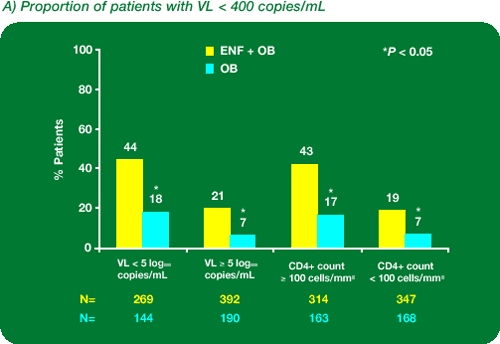 |
|
| |
| |
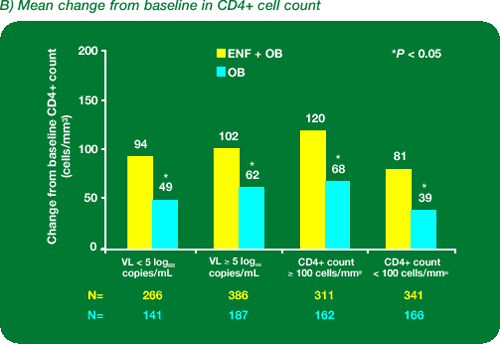 |
|
| |
| |
Figure 3 |
|
| |
| |
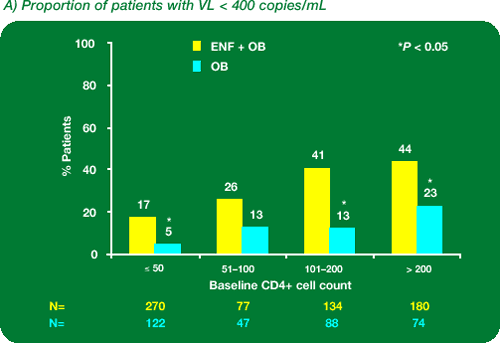 |
|
| |
| |
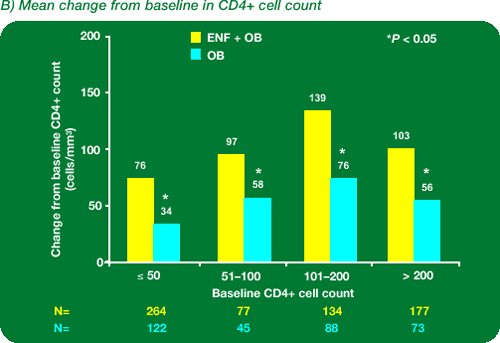 |
|
| |
| |
Figure 4 |
|
| |
| |
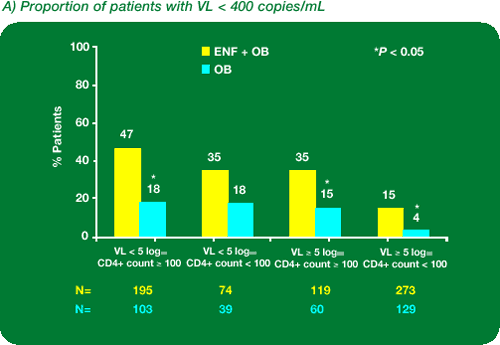 |
|
| |
| |
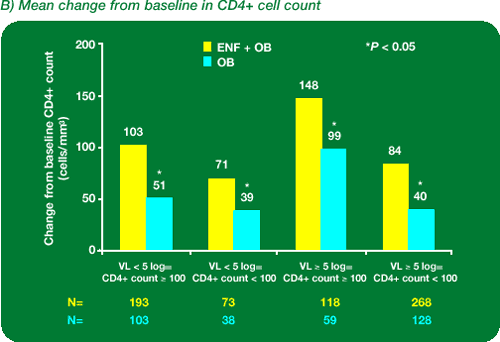 |
|
| |
| |
Figure 5 |
|
| |
| |
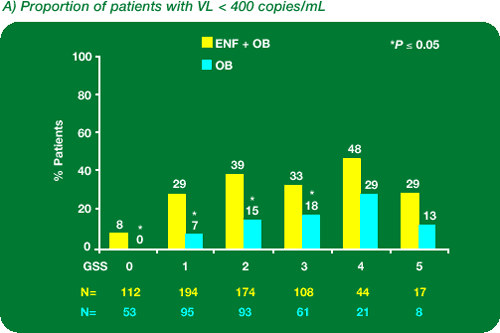 |
|
| |
| |
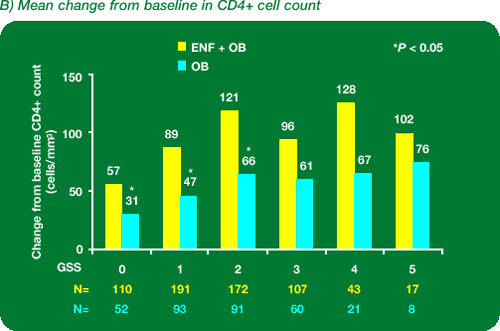 |
|
| |
|
 |
 |
|
|